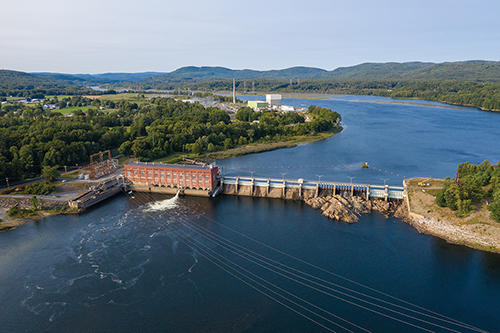Relicensing Major Power Plants
Photos by Christopher Zajac
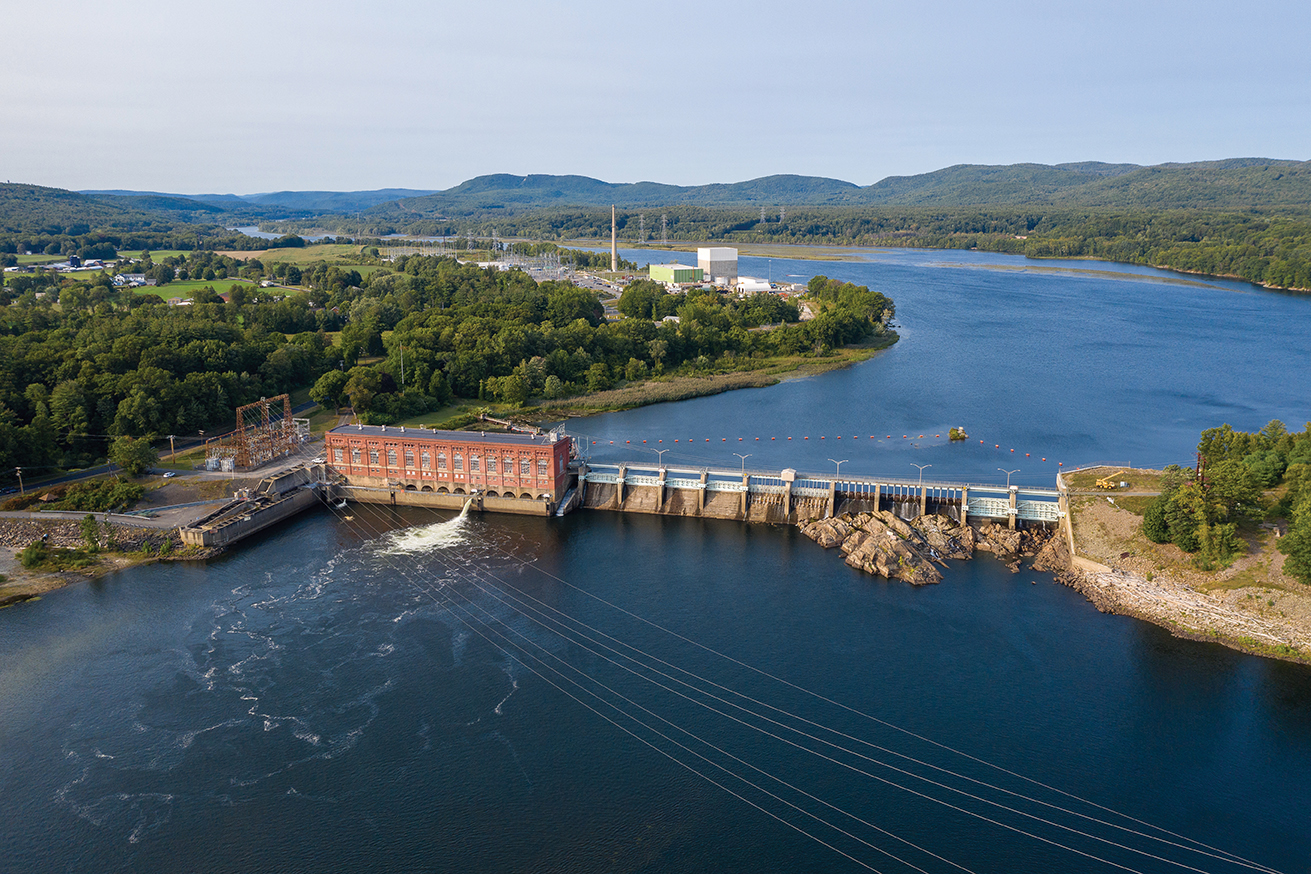
The Vernon Dam in Vernon, Vermont, is one of several dams undergoing relicensing with the Federal Energy Regulatory Commission. The fish ladder is to the left of the powerhouse. Upstream the Vermont Yankee Nuclear Power Station, no longer in operation, is seen on the banks of the River.
Believe it or not, there are more than 3,000 dams on the mighty Connecticut River and its myriad tributaries.
Sixty-five of these are “major dams” that produce measurable “hydrologic alteration” of the river basin, according to the US Army Corps of Engineers.
In layman’s terms, these sixty-five imposing barriers affect the water’s flow, elevation, and temperature—measurably impacting the riverine environment and many of the species that depend on it, including our own. According to The Nature Conservancy, the Connecticut River is one of the most heavily dammed waterways in North America.
Sixteen dams span the river’s 410-mile-long main stem. Some dams were designed to stop the natural flooding that once devastated—and also nurtured—the watershed. Others collect drinking water for nearly five million people. Of course, what is good for our species is quite often not good for other living things.
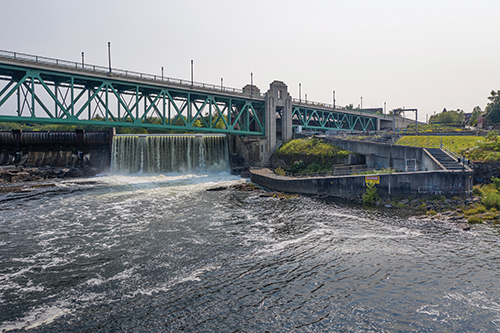
The Connecticut River spills over the Turners Falls Dam under the Turners Falls–Gill Bridge in Montague, MA, in September. To the right of the falls is one of the fish ladders in the area. The Number One Station powerhouse and entrance to the power canal is just under the bridge behind the fish ladder.
By early 2021, two power companies that operate four large hydroelectric dams and one associated pumping station on the Connecticut River are expected to submit final relicensing applications to the Federal Energy Regulatory Commission (FERC). These five facilities, which account for more than 40 percent of the hydropower capacity in New England, were last certified half a century ago, when far less was known about how they impaired fish passage and habitat for species such as Atlantic salmon, freshwater mussels, shorebirds, sea lamprey, and blueback herring.
The journeys up and down the River of thirteen species of migratory fish are significantly affected by this cohort of dams. American shad is the object of a longtime but declining fishery on the lower Connecticut River. The annual harvest has been dwindling for years, and there are now only six people licensed to take shad commercially in Connecticut. An anadromous species, shad return from salt waters to their home rivers to spawn where they historically traveled unimpeded as far north as Bellows Falls, Vermont.
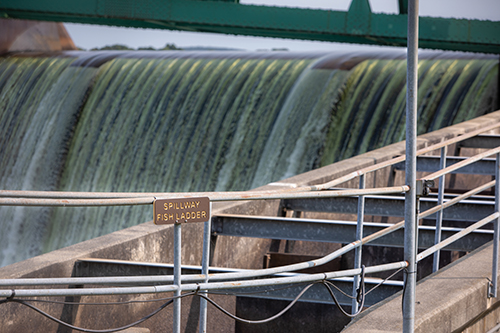
A fish ladder connects the lower Connecticut River with the river above Turners Falls.
It turns out that what happens at the Turners Falls Dam in Massachusetts, some ninety miles upriver from Long Island Sound, affects what goes on in Old Lyme, Connecticut, at the river’s mouth. Amazingly, this dam has presented a formidable obstacle to shad and other migratory species since 1798.
Shortnose sturgeon was another lucrative catch a century ago, but it has been listed as an endangered species since 1967. “It took about thirty years to basically wipe that fishery out,” said Andrew Fisk, executive director of the nonprofit Connecticut River Conservancy, an advocacy organization that is closely following the relicensing process.
 How shad, sturgeon, and their fellow travelers will fare in the decades to come will depend in large measure on the relicensing of five large hydro projects on the Connecticut River: Turners Falls Dam and Northfield Mountain Pumping Station in Massachusetts and three dams in Vermont: Vernon, Bellows Falls, and Wilder. In 2021, the applications from the two power companies that operate these facilities will be under scrutiny by federal agencies as well as state officials from Massachusetts, New Hampshire, and Vermont—and from the public.
How shad, sturgeon, and their fellow travelers will fare in the decades to come will depend in large measure on the relicensing of five large hydro projects on the Connecticut River: Turners Falls Dam and Northfield Mountain Pumping Station in Massachusetts and three dams in Vermont: Vernon, Bellows Falls, and Wilder. In 2021, the applications from the two power companies that operate these facilities will be under scrutiny by federal agencies as well as state officials from Massachusetts, New Hampshire, and Vermont—and from the public.
By law, surface waters belong to the people. Great River Hydro of North Walpole, New Hampshire, and FirstLight Power of Burlington, Massachusetts, are asking for permission to continue manipulating those waters to turn turbines and to turn a profit.
Great River Hydro is seeking approval to run its three hydro plants in Vermont: Vernon, Bellows Falls, and Wilder. The last is the northernmost of the three dams, more than 200 miles upriver from Long Island Sound. FirstLight’s application is for the Turners Falls Dam in northern Massachusetts and its companion facility, the Northfield Mountain Pumping Station. A pumping station allows for the diversion of water from the river so that it can be released later to generate power to meet demand, usually when the kilowatt price is higher.
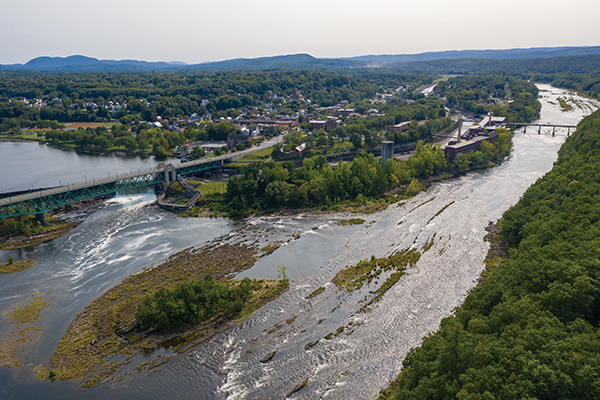
The Connecticut River flows over Turners Falls Dam, at left, before turning sharply south. Flow is usually diverted through one hydroelectric powerhouse, down the manmade power canal that runs between the river and the village of Turners Falls, and after 2.1 miles, out the Cabot Station powerhouse back into the Connecticut River.
Monitoring or participating in the relicensing process for hydropower facilities is not for the faint of heart. In addition to federal and state agencies, myriad consultants, researchers, and nonprofits like The Connecticut River Conservancy and The Nature Conservancy are involved. The relicensing process began in 2013. More than seventy scientific studies and thousands of pages of information, testimony, and comments are already in the public record. Great River Hydro alone authored thirty-three of the studies and was still working on some of them in mid-September 2020, according to spokesman John Ragonese, the company’s federal license manager. He declined to comment on contents of the final application.
FirstLight has conducted forty studies and as of August 2020 was still working on its final application after receiving a request for more information from the US Fish and Wildlife Service. A spokesman from FirstLight also declined to comment on specifics, including the submittal date of its final application. It will be a public document once it is filed with the Federal Energy Regulatory Commission.
There are, however, publicly available statistics that shed light on areas where environmental stewardship could be improved—for example, by comparing the fish passage numbers for the Holyoke Dam (which is not part of this relicensing process) with FirstLight’s Turners Falls Dam (which is). The US Fish and Wildlife Service reported in July 2020 that this spring 314,361 American shad, swimming upriver to spawn, safely passed Holyoke and headed north for the next obstacle: the Turners Falls Dam, which allowed just 41,252 of the fish to pass. Some 760 blueback herring successfully ascended Holyoke, but only 3 got by Turners, whose passage number for American eels was zero, compared with 2,645 at Holyoke.
This discrepancy, which has been known for decades, is largely due to the fact that Holyoke has a fish lift, or elevator, that boosts the fish up and over the dam, while species arriving at Turners have to climb fish ladders, which are essentially man-made waterfalls. The ladders were mandated to help Atlantic salmon ascend but are less well suited for species like shad.
“Right now they have poor fish passage at Turners Falls that is out of compliance with federal goals, but those goals are not in their current license,” said Andrew Fisk, executive director of the Connecticut River Conservancy. “We’d been in discussions with them from the late 1990s up to 2010 on how to fix this, but the company took no action, pointing to the license application process that would begin in 2013, saying they would do it then. They were able to get another 10 years without having to make infrastructure improvements.”
“We want 75 percent of the fish that reach a dam to pass upstream,” said Ken Sprankle, US Fish and Wildlife Service project leader for the Connecticut River Fish and Wildlife Conservation Office. He added that Turners Falls passes only about 10 to 15 percent of the fish that reach it.
In addition to improved upstream passage, the US Fish and Wildlife Service has set a target of 95 percent survival rate for fish heading downstream. The mortality rate of fish that pass through the turbines at Turner’s Falls, for example, is greater than 20 percent, according to Sprankle. “The mortality rate of fish going through the turbines is unacceptable,” he said, adding that the dam also has a safer bypass route that is taken by some 40 percent of descending fish. The ultimate goal of improved fish passage, according to Sprankle, is to have shad and other species make use of underutilized river habitat upstream of Turners Falls and the other three dams in the relicensing process.
Len Greene, director of government affairs and communications for FirstLight, which owns Turners Falls, would not comment on the specifics of what the company will include in its application. “When we do file, the amended final license application will address all of the pertinent issues that we need to address according to what the federal government and the state [of Massachusetts] are looking to require,” he said. “I will say that whatever is required under the current license will be vastly improved; the environmental impact of the resources that we own will be substantially improved. That’s a guarantee.”
In addition to improving fish passage, governmental and private stakeholders in the relicensing process are concerned about how dams alter the natural flow of the River, holding back or releasing water based on economic considerations alone. This process, called peaking, can change not just the level and pace of the water, but its temperature and the amount of sediment it deposits as well. Species affected by such activity include not just fish and freshwater mussels but also plants, birds, and animals in the River’s floodplain.
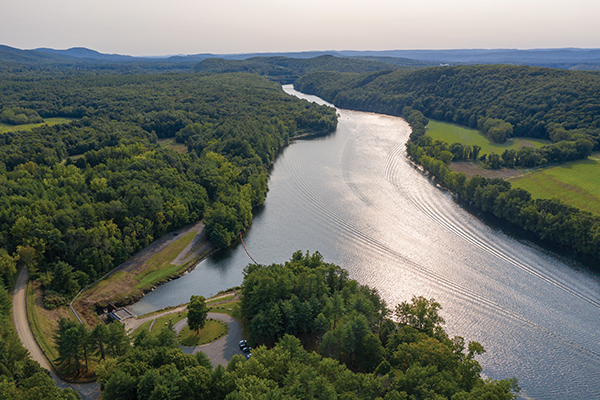
A view south down the Connecticut River as it flows past the Northfield Mountain intake and outlet for the pumped storage facility in Massachusetts.
Regarding the artificial and regular raising and lowering of river levels, Kathryn Kennedy, a scientist with The Nature Conservancy, said, “Species don’t do well typically in systems like that.” She led a recently completed report, The Connecticut River Flow Restoration Study, which was conducted by The Nature Conservancy in collaboration with the US Army Corps of Engineers and other partners. “There are ways to manage the river to provide the energy that’s needed while mitigating and minimizing some of those effects,” she said. The study identifies the environmental impact of various flow patterns and provides “the basis for potential improvements in dam management.”
The ultimate goal would be to get the River to flow more naturally while still meeting the needs of the power grid, satisfying the bottom lines of the hydro companies, and providing for the safety of human populations downstream. It’s a tall order. One rapidly advancing technology that has the potential to help achieve steady-flow generation is lithium-ion storage batteries. The New York Power Authority has joined with Cadenza Innovation, a Connecticut firm, to test its advanced batteries by establishing a demonstration facility this year.
“The economics of battery storage are changing dramatically,” Andrew Fisk said. “It would be a great solution to stop peaking power and allow companies to harvest waterpower and sell it at a better price while not damaging the river as much.”
Kathryn Kennedy said, “We’re very interested in storage batteries, and the technology is almost there, but not quite; I think there is a lot of potential there, and it will probably be a solution at some point.”
When the two applications are received by FERC, the agency will determine if the companies need to provide additional information. At some point soon the applications will be final—public and citizens can weigh in. When FERC accepts the documents as complete, the states where the dams are located have a year to certify whether the two applicants have met their water quality standards.
One thing in this complex and highly technical process is certain—the hydroelectric dams will keep operating. No one expects them to be taken offline. FERC reports that waterpower accounts for 8 percent of total electric generating capacity in the United States and 48 percent of the renewable power nationwide. In a world beset with increasingly alarming impacts of climate change, hydropower can be a key part of the solution.
But that doesn’t mean the water has to flow like it’s 1970, according to Andrew Fisk. “The way you would make a typical hydropower facility to have a much smaller ecological impact would be run-of-river flow, so the water is always moving through the turbines,” he said. “And therefore, the river would fluctuate more or less naturally; you would have up and down stream passage—safe, effective, and timely, those are key words—for all migratory fish.”
Ken Sprankle of the US Fish and Wildlife Service put it this way: “The companies did what they were obligated to do under their current license. But we’re not where we need to be; this is our next bite at the apple. We have to redo this.”
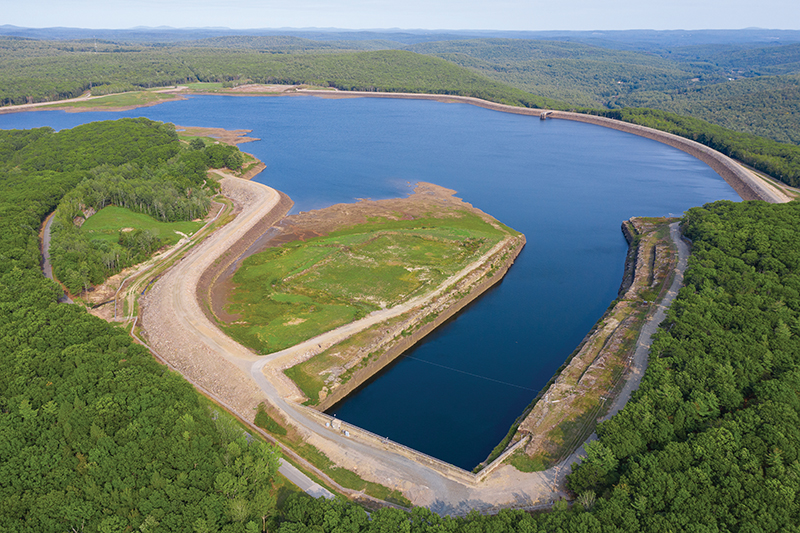
The Northfield Mountain Reservoir covers 300 acres and holds 5.6 billion gallons of water. When released, the water turns the four turbines in the powerhouse below for station nameplate production of 1,146 megawatts. In pump mode, the station can pump up to 6.7 million gallons of water a minute from the Connecticut River into the reservoir.

